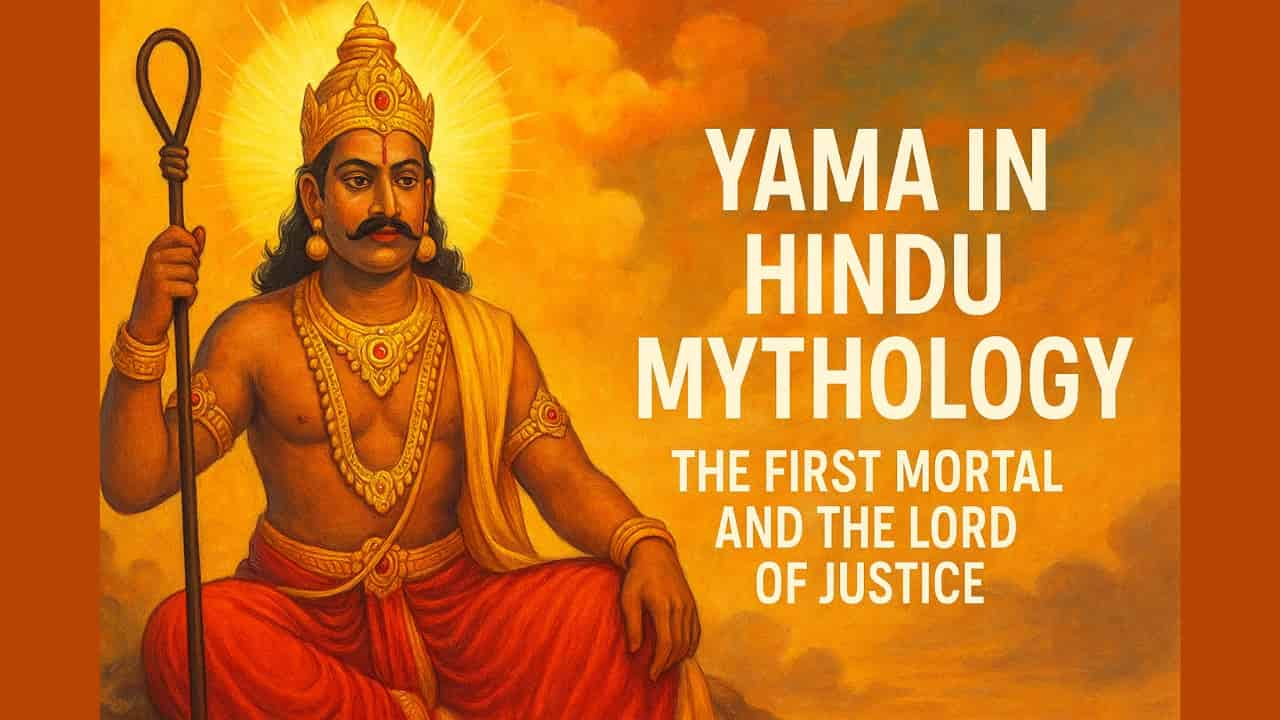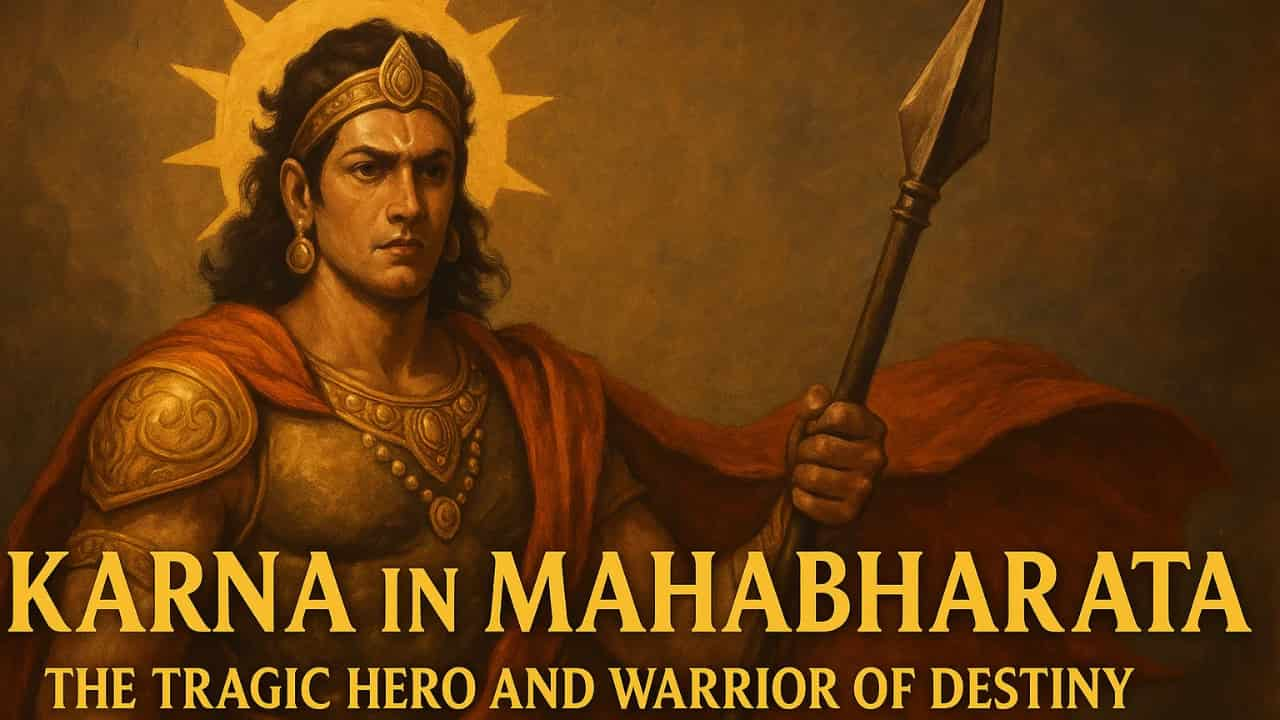
Yama in Hindu Mythology: The First to Crossover
When people first wondered about death, Yama was the first to walk into it. Because he went before everyone else, he became the figure who guides and watches over those who die.
Over time, stories about him helped people make sense of loss; communities developed rituals and teachings around his role so families could find meaning and comfort when someone passed away.
Yama in Hindu Mythology: Origin in the Vedas
In the Rigveda, Yama is honored as the first ancestor who found the way to the afterlife. He is not shown as frightening but as a guide who protects the dead and helps them on their journey.
These hymns treat him with respect and describe him as someone who keeps order; his presence reassured early communities that death had a place in a larger moral and spiritual system.
The Twin of Life
Yama’s father is Vivasvan (the sun), and his twin sister is Yami, who stays with the living and represents life and love. Yama chose the path of death. Their separation became a basic way to explain life and death, not a punishment but a role Yama took on for others’ benefit.
This twin story helps explain balance: one sibling is linked to everyday life, the other is linked to what comes after, giving families a simple moral framework.
Yama in Hindu Mythology: The Path Maker
Because he was the first to die, Yama in Hindu mythology is seen as the one who shows the way to Pitrloka (the realm of ancestors). He keeps the connection between the living and the dead and looks after those who have passed.
People believed he made the route safe and known, which allowed communities to perform ceremonies that honored ancestors and kept memories alive across generations.
The Lord of Dharma
Yama in Hindu mythology also stands for dharma, the moral order.
- He judges people not by money or power but by their intentions and actions.
- His rulings are meant to be fair and restore balance.
- He is the embodiment of cosmic law, the silent force that ensures harmony.
This role links ethical behavior in life with outcomes after death, encouraging people to act honestly and responsibly because their choices matter beyond the present life.
The Staff and the Noose
Yama is often shown holding a staff and a noose. The staff is for authority and guidance; the noose represents the pull toward the next life. He rides a buffalo, which suggests steadiness and calm rather than violence. These symbols made his responsibilities clear to ordinary people: he leads, he marks transition, and he moves slowly and steadily, never rushing the natural process.
Yama does not hunt; he waits. He does not punish, he reveals.
Yama in Hindu mythology: The Buffalo Mount
Yama rides a buffalo, a creature of strength and steadiness. The buffalo moves slowly, deliberately, without haste. It reflects Yama’s nature: calm, patient, unwavering. The mount is not fierce; it is grounded. It carries the weight of judgment, the burden of truth, the rhythm of time.
Yama in the Mahabharata
In the Mahabharata, Yama appears as Dharma, the father of Yudhishthira.
Yudhishthira’s commitment to truth and duty reflects Yama’s values. Yama’s role in the epic shows how moral choices matter in difficult situations. The story uses his presence to stress the practical side of dharma, how truth and fairness affect real lives, families, and the decisions leaders must take.
Yama’s presence in the epic is subtle but profound; he is the conscience behind the conflict, the law behind the chaos.
The Mirror of Karma
Yama in Hindu mythology doesn’t make fate; he reflects it. He looks at actions and intentions and shows their results. His role is to reveal what follows from what we do, not to punish out of hatred.
By framing judgment as a reflection of past behavior, people learned to take responsibility for their actions and to think about long-term consequences rather than short-term gain.
The Realm of the Ancestors
Pitrloka, the realm of ancestors, is a place of rest and memory. Families perform rituals like Shraddha and Tarpana to honor their ancestors.
During Pitru Paksha, people offer food and prayers; Yama is invoked as the one who receives these offerings and watches over the ancestors. These practices keep ties between generations, supporting social stability and giving people a regular way to remember those who came before.
The Festival of Pitru Paksha
During Pitru Paksha, families honor their ancestors. Offerings are made, prayers are chanted, and stories are told. Yama in Hindu mythology is invoked as the guardian of this sacred time.
He receives the offerings, carries them to the departed, and blesses the living. The festival is not about mourning; it is about gratitude, remembrance, and connection.
Yama and the Cycle of Time
Yama is described as outside ordinary time. He observes long cycles, the rise and fall of peoples, the lifetime of stars. His perspective reminds us that life is part of a larger flow.
Thinking this way helped communities see individual lives as connected to larger patterns, encouraging patience, long-term planning, and a focus on what truly matters over passing worries.
The Fear of Death
Fear of death usually comes from attachment, not from Yama. He is calm and impartial. His presence asks us to view death as a transition rather than an end.
Understanding this can reduce anxiety: if death is a natural step, people may accept loss more calmly and focus on relationships, duties, and unfinished responsibilities while they still can.
Teacher of Seekers: Yama in Hindu Mythology
In the Katha Upanishad, Yama teaches Nachiketa about the self and what lies beyond death. He explains that the soul is constant and that liberation comes through knowledge and inner discipline. His role as teacher shows that spiritual learning matters; it suggests a path where clear thinking, discipline, and ethical living lead to deeper understanding and relief from fear.
Nachiketa's Questions
Nachiketa asks Yama: What happens after death? What is the nature of the self? What is the secret of immortality?
Yama answers with depth and compassion. He explains that the soul is eternal, that liberation comes through knowledge, and that truth is the highest path. The dialogue becomes a cornerstone of Indian philosophy.
The Balance of Justice
Yama’s justice takes motive and context into account. He aims to restore balance and promote growth, not to punish for its own sake. This makes his judgments more humane: they consider why someone acted and whether they can learn from their mistakes, which fits social goals of repair and improvement rather than only retribution.
Yama in Hindu mythology: Art and Iconography
Art often shows Yama crowned, holding his staff, and riding a buffalo. These images stress dignity and calm, not terror.
Visuals like these made the idea of death less frightening and more orderly for ordinary people; temples and paintings provided a familiar image that helped people accept and deal with loss.
The Eternal Witness
Yama is a figure who helps people understand death and moral order. He guides the dead, judges fairly, and teaches about the soul. Remembering Yama points us toward honesty, careful action, and facing endings with dignity. Keeping these lessons in daily life can encourage steady behavior and offer comfort when families deal with loss.
Final Reflections: Yama in Hindu Mythology
Yama’s story can be useful in everyday life.
First, the idea that actions matter encourages personal responsibility. If people accept that intentions and choices have effects, they are more likely to act clearly and fairly. This simple lesson supports good behavior at home, work, and in public life.
Rituals that honor ancestors build social ties. When families set aside time to remember older generations, they pass on stories, values, and practical advice. These practices help communities stay connected and give people a warm, shared way to handle grief and memory.
Seeing death as a transition can change how we live. If endings are part of a longer process, we may spend less time on small fears and more on relationships and duties. This outlook can reduce worry and make choices about what matters more straightforwardly.
Finally, these lessons are practical: act responsibly, honor family ties, accept life’s limits, design fair systems, and value learning. Applying these simple ideas helps people live with less fear of loss and more care for others.

